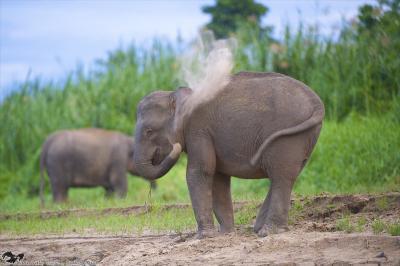Studying the genetic variability of endangered species will be necessary for species conservation and monitoring but endangered species are difficult to observe and sample and typically have very limited genetic diversity.
A research team has taken advantage of DNA sequencing methodology developed by Floragenex to identify the genetic markers for the Bornean elephant, an endangered species, using blood from very few animals. The results showed that Bornean elephants have very low genetic variability that can impact on their survival to a threatened habitat, but that variable genetic markers can still be identified. The study opens new avenues for the conservation of other endangered species.
The Bornean elephant is a unique subspecies of the Asian elephant, with a quite distinct morphology and behavior. They are generally smaller than other elephants, with straight tusks and a long tail. Currently, there are around 2,000 individuals, located only in the North of Borneo. It remains unknown how this population of elephants evolved to become so different and why its distribution is so restricted.

A Bornean elephant in the wild. Credit: Rudi Delvaux/DGFC
Despite being one of the highest priority populations for Asian elephant conservation, until now there were limited genetic tools available to study its genetic variability and none that had been specifically designed for this species. The research team used two different DNA sequencing technologies that are fast and increasingly cheaper. This kind of technology has been used for common laboratory species such as mice and fruit-flies, but they are only now starting to be used on endangered and "non-model" species.
Until now, in order to determine whether the species still harboured sufficient genetic diversity it was necessary to look through huge regions of the genome, using classical genetics methodologies, or use markers developed for other species, with varying levels of success. This approach can become unsustainable for the endangered species, whose numbers have gone bellow a certain size for long time.
The only study that previously had tried to analyze Bornean elephants, using genetic markers developed for other Asian elephants had found nearly no genetic diversity. The work now developed demonstrates that if the methodology can be applied to the Bornean elephant, it should be possible to find the needles we need, and not get stuck with the hay, i.e., to find variable genetic markers in many other species.
The DNA analysis done resulted from blood samples collected only from seven Bornean elephants from the Lok Kawi Wildlife Park (Sabah, Malaysia) and from Chendra, the star elephant of Oregon zoo (Portland, USA). But, the research team is confident that these DNA sequencing methods can be used to type genetically other biological samples, such as hair or faeces, easier to obtain from wild animals, even though blood or tissue samples are still necessary to identify the markers during the first steps.
Reeta Sharma, first author of this work, says, "The methodology applied to identify the genetic markers for the Bornean elephant can be used in the future for studies on the genetic variability of other species or populations facing the risk of extinction."
The Bornean elephants live in an environment where natural habitats disappear quickly, due to oil palm plantations and populations get isolated from each other. Having access to variable genetic markers will be crucial to identify populations that are isolated and genetically depauperate, and monitor them in the future.
The origin of these elephants in Borneo raises controversy that has been long discussed. The only study done on the basis of genetic data concluded that they had been present in Borneo for more than 300,000 years. This theory does not satisfy all researchers as there is lack of elephant fossils in Borneo to support it. Another theory is that the sultan of Java sent Javan elephants as a gift to the sultan of Sulu, who would have introduced them to Borneo.
Lounes Chikhi suggests, "The new genetic markers that we found may also allow us to unravel the mystery of the origin of these elephants in Borneo, and perhaps reconstruct part of their demographic history. This is very exciting."






Comments